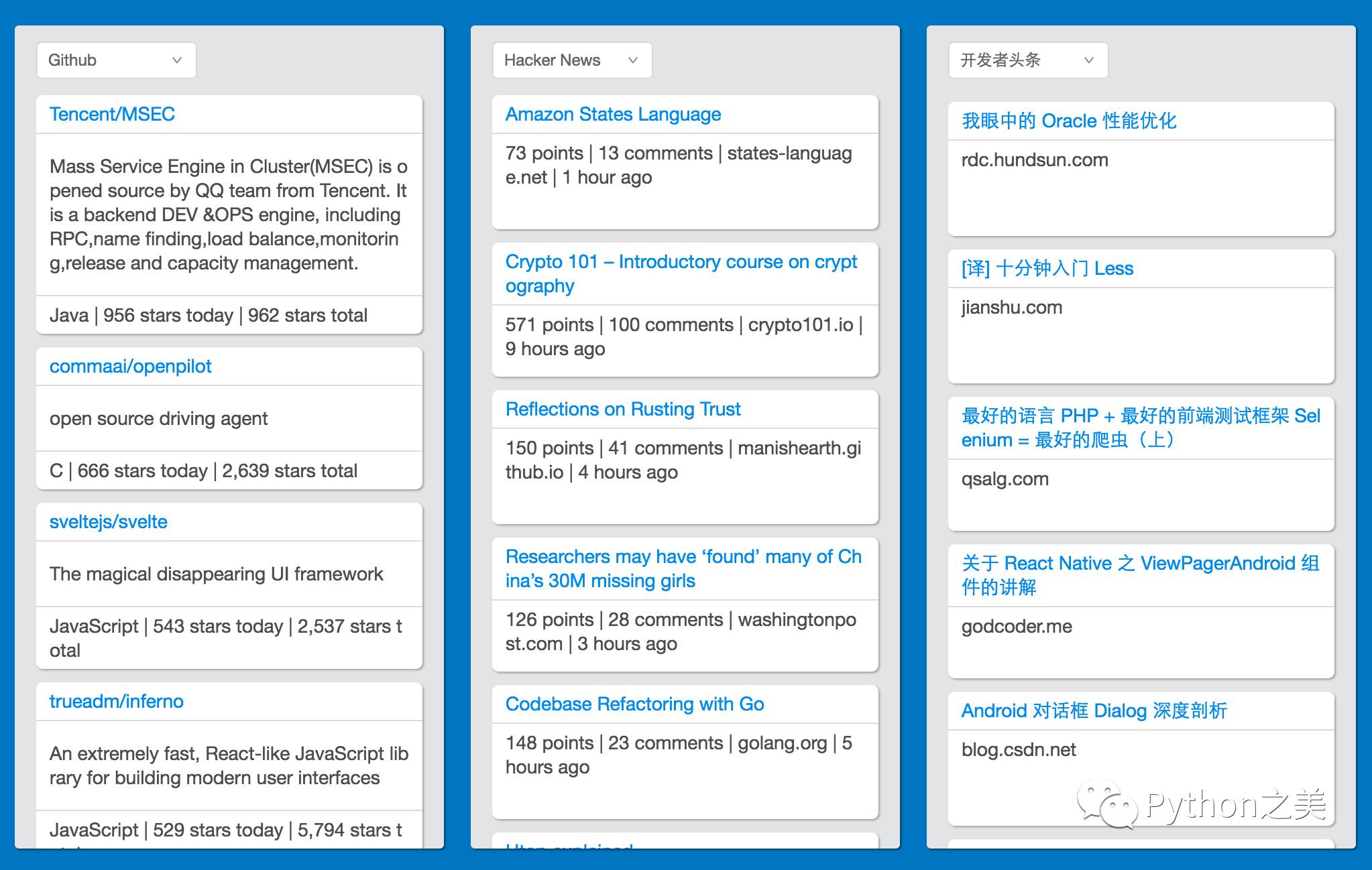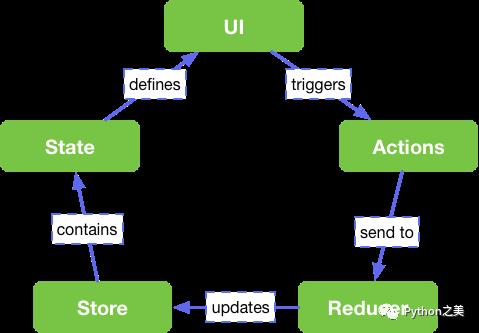Flask+React 的全栈开发和部署
Posted Python之美
tags:
篇首语:本文由小常识网(cha138.com)小编为大家整理,主要介绍了Flask+React 的全栈开发和部署相关的知识,希望对你有一定的参考价值。
作者: FunHacks
原文链接:
已授权发布
简介
我有时在 Web 上浏览信息时,会浏览 , 和 等技术社区的资讯或文章,但觉得逐个去看很费时又不灵活。后来我发现国外有一款叫 的产品,它聚合了互联网大多数领域的信息,使用起来确实很不错,唯一的遗憾就是没有互联网中文领域的信息,于是我就萌生了一个想法:写个爬虫,把经常看的网站的资讯爬下来,并显示出来。
有了想法,接下来就是要怎么实现的问题了。虽然有不少解决方法,但后来为了尝试使用 React,就采用了 Flask + React + Redux 的技术栈。其中:
Flask 用于在后台提供 api 服务
React 用于构建 UI
Redux 用于数据流管理
目前项目已经实现了基本功能,项目源码:。目前界面大概如下:

前端开发
前端的开发主要涉及两大部分:React 和 Redux,React 作为「显示层」(View layer) 用,Redux 作为「数据层」(Model layer) 用。
我们先总体了解一下 React+Redux 的基本工作流程,一图胜千言(该说的基本都在图里面了):

我们可以看到,整个数据流是单向循环的:
Store -> View layer -> Action -> Reducer
^ |
| |
--------- 返回新的 State -------------
Store表示「存放状态」;view layer:表示「显示状态」;Reducer:表示「处理动作」。
其中:
React 提供应用的 View 层,表现为组件,分为容器组件(container)和普通显示组件(component);
Redux 包含三个部分:Action,Reducer 和 Store:
Action 本质上是一个 JS 对象,它至少需要一个元素:type,用于标识 action;
Middleware(中间件)用于在 Action 发起之后,到达 Reducer 之前做一些操作,比如异步 Action,Api 请求等;
Reducer 是一个函数:(previousState, action) => newState,可理解为动作的处理中心,处理各种动作并生成新的 state,返回给 Store;
Store 是整个应用的状态管理中心,容器组件可以从 Store 中获取所需要的状态; 项目前端的源码在 client 目录中,下面是一些主要的目录:
client
├── actions # 各种 action
├── components # 普通显示组件
├── containers # 容器组件
├── middleware # 中间间,用于 api 请求
├── reducers # reducer 文件
├── store # store 配置文件
React 开发
React 部分的开发主要涉及 container 和 component:
container 负责接收 store 中的 state 和发送 action,一般和 store 直接连接;
component 位于 container 的内部,它们一般不和 store 直接连接,而是从父组件 container 获取数据作为 props,所有操作也是通过回调完成,component 一般会多次使用;
在本项目中,container 对应的原型如下:

而 component 则主要有两个:一个是选择组件,一个是信息显示组件,如下:

这些 component 会被多次使用。
下面,我们主要看一下容器组件 (对应 App.js) 的代码(只显示部分重要的代码):
import React, { Component, PropTypes } from 'react';
import { connect } from 'react-redux';
import Posts from '../../components/Posts/Posts';
import Picker from '../../components/Picker/Picker';
import { fetchNews, selectItem } from '../../actions';
require('./App.scss');
class App extends Component {
constructor(props) {
super(props);
this.handleChange = this.handleChange.bind(this);
}
componentDidMount() {
for (const value of this.props.selectors) {
this.props.dispatch(fetchNews(value.item, value.boardId));
}
}
componentWillReceiveProps(nextProps) {
for (const value of nextProps.selectors) {
if (value.item !== this.props.selectors[value.boardId].item) {
nextProps.dispatch(fetchNews(value.item, value.boardId));
}
}
}
handleChange(nextItem, id) {
this.props.dispatch(selectItem(nextItem, id));
}
render() {
const boards = [];
for (const value of this.props.selectors) {
boards.push(value.boardId);
}
const options = ['Github', 'Hacker News', 'Segment Fault', '开发者头条', '伯乐头条'];
return (
<div className="mega">
<main>
<div className="desk-container">
{
boards.map((board, i) =>
<div className="desk" style={{ opacity: 1 }} key={i}>
<Picker value={this.props.selectors[board].item}
onChange={this.handleChange}
options={options}
id={board}
/>
<Posts
isFetching={this.props.news[board].isFetching}
postList={this.props.news[board].posts}
id={board}
/>
</div>
)
}
</div>
</main>
</div>
);
}
}
function mapStateToProps(state) {
return {
news: state.news,
selectors: state.selectors,
};
}
export default connect(mapStateToProps)(App);
其中,
constructor(props) 是一个构造函数,在创建组件的时候会被调用一次;
componentDidMount() 这个方法在组件加载完毕之后会被调用一次;
componentWillReceiveProps() 这个方法在组件接收到一个新的 prop 时会被执行;
上面这几个函数是组件生命周期(react component lifecycle)函数,更多的组件生命周期函数可在此查看。
react-redux 这个库的作用从名字就可看出,它用于连接 react 和 redux,也就是连接容器组件和 store;
mapStateToProps 这个函数用于建立一个从(外部的)state 对象到 UI 组件的 props 对象的映射关系,它会订阅 Store 中的 state,每当有 state 更新时,它就会自动执行,重新计算 UI 组件的参数,从而触发 UI 组件的重新渲染;
Redux 开发
上文说过,Redux 部分的开发主要包含:action,reducer 和 store,其中,store 是应用的状态管理中心,当收到新的 state 时,会触发组件重新渲染,reducer 是应用的动作处理中心,负责处理动作并产生新的状态,将其返回给 store。
在本项目中,有两个 action,一个是站点选择(如 Github,Hacker News),另一个是信息获取,action 的部分代码如下:
export const FETCH_NEWS = 'FETCH_NEWS';
export const SELECT_ITEM = 'SELECT_ITEM';
export function selectItem(item, id) {
return {
type: SELECT_ITEM,
item,
id,
};
}
export function fetchNews(item, id) {
switch (item) {
case 'Github':
return {
type: FETCH_NEWS,
api: `/api/github/repo_list`,
method: 'GET',
id,
};
case 'Segment Fault':
return {
type: FETCH_NEWS,
api: `/api/segmentfault/blogs`,
method: 'GET',
id,
};
default:
return {};
}
}
可以看到,action 就是一个普通的 JS 对象,它有一个属性 type 是必须的,用来标识 action。
reducer 是一个含有 switch 的函数,接收当前 state 和 action 作为参数,返回一个新的 state,比如:
import { SELECT_ITEM } from '../actions';
import _ from 'lodash';
const initialState = [
{
item: 'Github',
boardId: 0,
},
{
item: 'Hacker News',
boardId: 1,
}
];
export default function reducer(state = initialState, action = {}) {
switch (action.type) {
case SELECT_ITEM:
return _.sortBy([
{
item: action.item,
boardId: action.id,
},
...state.filter(element =>
element.boardId !== action.id
),
], 'boardId');
default:
return state;
}
}
再来看一下 store:
import { createStore, applyMiddleware, compose } from 'redux';
import thunk from 'redux-thunk';
import api from '../middleware/api';
import rootReducer from '../reducers';
const finalCreateStore = compose(
applyMiddleware(thunk),
applyMiddleware(api)
)(createStore);
export default function configureStore(initialState) {
return finalCreateStore(rootReducer, initialState);
}
其中,「applyMiddleware() 」用于告诉 redux 需要用到那些中间件,比如异步操作需要用到 thunk 中间件,还有 api 请求需要用到我们自己写的中间件。
后端开发
后端的开发主要是爬虫,目前的爬虫比较简单,基本上是静态页面的爬虫,主要就是 html 解析和提取。如果要爬取稀土掘金和知乎专栏等网站,可能会涉及到登录验证,抵御反爬虫等机制,后续也将进一步开发。
后端的代码在 server 目录:
├── __init__.py
├── app.py # 创建 app
├── configs.py # 配置文件
├── controllers # 提供 api 服务
└── spiders # 爬虫文件夹,几个站点的爬虫
后端通过 Flask 以 api 的形式给前端提供数据,下面是部分代码:
# -*- coding: utf-8 -*-
import flask
from flask import jsonify
from server.spiders.github_trend import GitHubTrend
from server.spiders.toutiao import Toutiao
from server.spiders.segmentfault import SegmentFault
from server.spiders.jobbole import Jobbole
news_bp = flask.Blueprint(
'news',
__name__,
url_prefix='/api'
)
@news_bp.route('/github/repo_list', methods=['GET'])
def get_github_trend():
gh_trend = GitHubTrend()
gh_trend_list = gh_trend.get_trend_list()
return jsonify(
message='OK',
data=gh_trend_list
)
@news_bp.route('/toutiao/posts', methods=['GET'])
def get_toutiao_posts():
toutiao = Toutiao()
post_list = toutiao.get_posts()
return jsonify(
message='OK',
data=post_list
)
@news_bp.route('/segmentfault/blogs', methods=['GET'])
def get_segmentfault_blogs():
sf = SegmentFault()
blogs = sf.get_blogs()
return jsonify(
message='OK',
data=blogs
)
@news_bp.route('/jobbole/news', methods=['GET'])
def get_jobbole_news():
jobbole = Jobbole()
blogs = jobbole.get_news()
return jsonify(
message='OK',
data=blogs
)
部署
本项目的部署采用 nginx+gunicorn+supervisor 的方式,其中:
nginx 用来做反向代理服务器:通过接收 Internet 上的连接请求,将请求转发给内网中的目标服务器,再将从目标服务器得到的结果返回给 Internet 上请求连接的客户端(比如浏览器);
gunicorn 是一个高效的 Python WSGI Server,我们通常用它来运行 WSGI (Web Server Gateway Interface,Web 服务器网关接口) 应用(比如本项目的 Flask 应用);
supervisor 是一个进程管理工具,可以很方便地启动、关闭和重启进程等; 项目部署需要用到的文件在 deploy 目录下:
deploy
├── fabfile.py # 自动部署脚本
├── nginx.conf # nginx 通用配置文件
├── nginx_geekvi.conf # 站点配置文件
└── supervisor.conf # supervisor 配置文件
本项目采用了 Fabric 自动部署神器,它允许我们不用直接登录服务器就可以在本地执行远程操作,比如安装软件,删除文件等。
fabfile.py 文件的部分代码如下:
# -*- coding: utf-8 -*-
import os
from contextlib import contextmanager
from fabric.api import run, env, sudo, prefix, cd, settings, local, lcd
from fabric.colors import green, blue
from fabric.contrib.files import exists
env.hosts = ['deploy@111.222.333.44:12345']
env.key_filename = '~/.ssh/id_rsa'
# env.password = '12345678'
# path on server
DEPLOY_DIR = '/home/deploy/www'
PROJECT_DIR = os.path.join(DEPLOY_DIR, 'react-news-board')
CONFIG_DIR = os.path.join(PROJECT_DIR, 'deploy')
LOG_DIR = os.path.join(DEPLOY_DIR, 'logs')
VENV_DIR = os.path.join(DEPLOY_DIR, 'venv')
VENV_PATH = os.path.join(VENV_DIR, 'bin/activate')
# path on local
PROJECT_LOCAL_DIR = '/Users/Ethan/Documents/Code/react-news-board'
GITHUB_PATH = 'https://github.com/ethan-funny/react-news-board'
@contextmanager
def source_virtualenv():
with prefix("source {}".format(VENV_PATH)):
yield
def build():
with lcd("{}/client".format(PROJECT_LOCAL_DIR)):
local("npm run build")
def deploy():
print green("Start to Deploy the Project")
print green("=" * 40)
# 1. Create directory
print blue("create the deploy directory")
print blue("*" * 40)
mkdir(path=DEPLOY_DIR)
mkdir(path=LOG_DIR)
# 2. Get source code
print blue("get the source code from remote")
print blue("*" * 40)
with cd(DEPLOY_DIR):
with settings(warn_only=True):
rm(path=PROJECT_DIR)
run("git clone {}".format(GITHUB_PATH))
# 3. Install python virtualenv
print blue("install the virtualenv")
print blue("*" * 40)
sudo("apt-get install python-virtualenv")
# 4. Install nginx
print blue("install the nginx")
print blue("*" * 40)
sudo("apt-get install nginx")
sudo("cp {}/nginx.conf /etc/nginx/".format(CONFIG_DIR))
sudo("cp {}/nginx_geekvi.conf /etc/nginx/sites-enabled/".format(CONFIG_DIR))
# 5. Install python requirements
with cd(DEPLOY_DIR):
if not exists(VENV_DIR):
run("virtualenv {}".format(VENV_DIR))
with settings(warn_only=True):
with source_virtualenv():
sudo("pip install -r {}/requirements.txt".format(PROJECT_DIR))
# 6. Config supervisor
sudo("supervisord -c {}/supervisor.conf".format(CONFIG_DIR))
sudo("supervisorctl -c {}/supervisor.conf reload".format(CONFIG_DIR))
sudo("supervisorctl -c {}/supervisor.conf status".format(CONFIG_DIR))
sudo("supervisorctl -c {}/supervisor.conf start all".format(CONFIG_DIR))
$ fab build
当然,你也可以直接到 client 目录下,运行命令:
$ npm run build
如果构建没有出现错误,就可以进行部署了,在 deploy 目录使用如下命令进行部署:
$ fab deploy
总结
本项目前端使用 React+Redux,后端使用 Flask,这也算是一种比较典型的开发方式了,当然,你也可以使用 Node.js 来做后端。
前端的开发需要知道数据的流向:

后端的开发主要是爬虫,Flask 在本项目只是作为一个后台框架,对外提供 api 服务;
参考资料
广告时间:欢迎参与我的首次知乎Live:「Python 工程师的入门和进阶」 https://www.zhihu.com/lives/789840559912009728, 可以通过下面的二维码直接进入:
以上是关于Flask+React 的全栈开发和部署的主要内容,如果未能解决你的问题,请参考以下文章